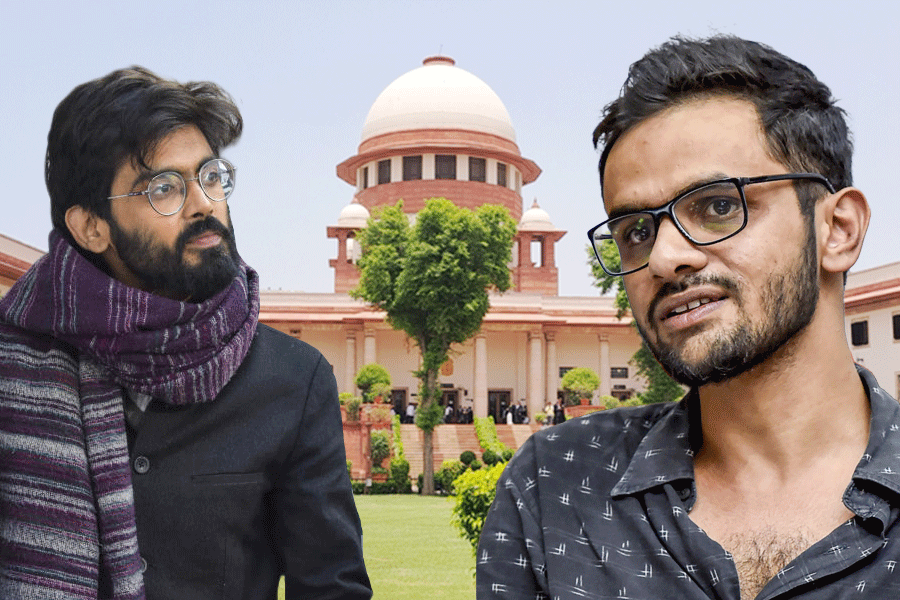 |
New Delhi, Jan. 8: Pakistani troops crossed the Line of Control today and killed two Indian soldiers — one of them was “mutilated” — in an “act of grave provocation”, the Indian government said.
The rhetoric between the Indian and Pakistani military establishments immediately escalated following the events in Jammu’s Mendhar sector but the two were also in touch through an officially institutionalised “hotline”.
The political leaders of the two governments have not escalated the rhetoric. That is more notable for India, where the military does not call the shots, than for Pakistan, where the army can swing government policy.
Army headquarters sources in New Delhi described the killings and the firefight as a “grave provocation” but would not comment on whether this could lead to an unravelling of the ceasefire that has been in effect since November 2003.
PTI reported from Jammu that the Pakistani troopers beheaded the two Indian soldiers. This was not confirmed by army sources in New Delhi. They said the two Indian soldiers killed were Lance Naik Hem Raj and Lance Naik Sudhakar Singh.
The army sources said the attackers were identified as Pakistani troops because they were in uniform.
News agencies reported from Islamabad that the Pakistan Army has denied the allegations. The army there accused Indian troops of attacking their post on Sunday.
The Indian foreign ministry denied any violation by Indian troops on Sunday. “We deny that Indian troops had crossed the Line of Control in the Rampur sector or had violated the ceasefire. The fact is that in the early hours of January 6, Pakistan troops in the sector commenced unprovoked firing on Indian troops. The roof of a civilian house in Churunda village was damaged in the Pak mortar fire. Indian troops undertook controlled retaliation in response,” it said.
But the statement added: “The Directors General for Military Operations (DGMOs) of both sides have spoken to each other on the incident. We call upon the Pakistani authorities to ensure that the sanctity of the Line of Control is upheld at all times, and to ensure that such incidents of unprovoked firing across the LoC do not recur.”
Two key points stand out in the allegation of ceasefire violation made by the Indian Army today.
First, that the Pakistani troops had actually crossed into Indian territory — not just aimed fire at Indian targets — taking advantage of the poor visibility. Second, that they had “mutilated” the body of a soldier (possibly beheaded) before heading back to their own territory.
The first charge means not only a violation of ceasefire but also a violation of the LoC. The second charge means that Indian troops are angry enough and a punitive action may be on the agenda.
The “mutilation” of a soldier is taken as a serious issue by armies since the Geneva Convention. The family of Capt. Saurabh Kalia, an Indian officer killed and mutilated in the 1999 Kargil war, has petitioned the Supreme Court seeking directives to the Indian government for reparations from Pakistan.
Do the two factors escalate military tensions between India and Pakistan? In the immediate term, yes. But does this mean that they are on the road to a larger conflict? That depends on how far up the escalatory ladder the tensions will climb. Politically, both New Delhi and Islamabad are committed to keep the ceasefire going.
In a statement, the Indian defence ministry said: “The Government of India considers the incident as a provocative action and we condemn it. DGMOs of the two countries are in touch over it. The government will take up the incident with the Pakistan government. We expect Islamabad to honour the ceasefire agreement strictly.”
The history of skirmishes along the Line of Control in Jammu and Kashmir is longer than the nine-year ceasefire that has been agreed since November 2003. Till November 2003, violence along the disputed border was almost a daily affair. It escalated into major conflicts — not full-fledged war — in 1999 (Kargil) and before that in Siachen (Actual Ground Position Line, 1984).
Ceasefire violations are usually followed by flag meetings between sector commanders. This time, the DGMOs were on the “hotline” — an institutionalised telephone link between the army headquarters in New Delhi and Rawalpindi.
There have been at least six ceasefire violations on the Line of Control in the past month, including one in which the Pakistan Army was alleged to have fired 82mm mortars at an Indian village near Poonch in Jammu.
There is a pattern that leads to escalation of violence in the LoC. As of today evening, Indian Army sources indicated that firing had expanded from the battalion-level to the brigade-level. This means that small arms and probably mortar-fire had spread from a few posts to cover an entire sector.
In Jammu and Kashmir, a brigade is in charge of a sector and may have up to three battalions under its command. But the level of military dissonance has to be gauged by the intensity of firing — whether artillery is involved, its spread to other sectors and its frequency of occurrence. It is still too early from the events of this morning to get a measure of the domino effect of ceasefire violations.
Today’s incident happened near Sona Gali in Mendhar, a hilly region near the LoC draped by heavy fog, an army officer said. An Indian Army column was patrolling between two posts overlooking Pakistani territory when they were attacked.
The Pakistani troops were alleged to have crossed through the fence on the Line of Control. The fence itself is in Indian territory. One officer estimated that the Pakistani attackers may have come about 500 metres inside Indian territory, outnumbered and outgunned the patrol and butchered a body “to take back a trophy”.
In Jammu, army sources said a Border Action Team (BAT) of the Pakistan Army entered the Indian territory at Krishna Ghati area of Poonch district and carried out the strikes. The army’s Udhampur-based Northern Command came out with a statement terming the attack as a “significant escalation” to the continuing series of ceasefire violations and infiltration attempts supported by the Pakistan Army.
“A group of their regular soldiers intruded across the Line of Control in the Mendhar sector on January 8. Pakistan army troops, having taken advantage of thick fog and mist in the forested area, were moving towards our posts when an alert area domination patrol spotted and engaged the intruders,” it said.










